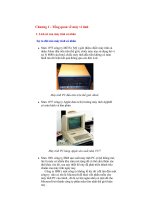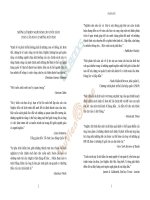Tutorial 1 GROSS DOMESTIC PRODUCT (GDP)
Bạn đang xem bản rút gọn của tài liệu. Xem và tải ngay bản đầy đủ của tài liệu tại đây (67.43 KB, 3 trang )
ECON7001Tutorial
1
Gross
Domestic
Product
Chapter
4
(To
be
discussed
in
Week
2)
Question
1
“Is
China
about
to
overtake
US
as
the
world's
largest
economy?”
-‐
BBC
30
April
2014
-‐
(a) By
what
economic
measure
is
this
claim
being
made?
(b) What
problems
arise
when
making
international
comparisons
of
economic
activity?
(c) Does
this
mean
China
is
wealthier
than
the
United
States?
Question
2
An
Australian
wool
farmer
sold
some
wool
to
a
local
textile
mill
for
$5.
The
textile
mill
spun
it
into
yarn
and
sold
it
to
Grandma
Jones
for
$8.
Grandma
Jones
runs
a
stall
at
the
Southbank
Markets
where
she
knits
the
yarn
into
a
custom
tea
cosy
and
sells
it
for
$10.
a) How
much
was
contributed
to
Australia’s
GDP.
How
much
value
was
added
at
each
step?
b) How
does
your
answer
change
if
Grandma
Jones
is
your
Grandma
and
rather
than
selling
the
tea
cosy,
she
gives
it
to
you
for
your
birthday?
c) How
does
your
answer
change
if
the
textile
mill
is
owned
by
a
Chinese
company?
d) How
does
your
answer
change
if
the
textile
mill
is
located
in
China?
a) Foreign
ownership
of
the
factory
doesn’t
change
GDP.
Remember
that
GDP
measures
everything
produced
in
some
place,
so
the
owner
of
the
mill
is
irrelevant
(this
effect
is
accounted
for
in
a
different
figure
called
Gross
National
Product).
1
b) The
“domestic”
in
gross
domestic
product
means
that
we
are
only
trying
to
account
production
that
occurred
within
a
particular
place
(in
this
case
Australia).
To
account
for
this
we
can
simply
disregard
the
value
added
by
the
foreign
textile
mill.
Value
added
by
the
farmer
is
$5
and
the
value
added
by
Grandma
is
$2,
so
domestic
GDP
is
now
increased
by
$7.
Question
3
Consider
the
following
production
data
for
the
made-‐up
country
of
Kuznetsistan,
which
produces
only
milk
and
juice.
2012
2013
Quantity
Price
Quantity
Price
Milk
10L
$2/L
8L
$4/L
Juice
5L
$1/L
9L
$2/L
a) Calculate
nominal
GDP
for
2012
and
2013
b) Calculate
the
growth
rate
in
nominal
GDP
between
these
years
c) What
can
be
concluded
about
the
economic
growth
rate
from
this
figure?
d) Calculate
real
GDP
for
2012
and
2013
using
2012
as
the
base
year
e) Calculate
the
growth
rate
in
real
GDP
between
these
years
f) What
can
be
concluded
from
this
figure?
g) Calculate
the
GDP
deflator
for
2012
and
2013.
What
does
this
number
mean?
Question
4
How
would
each
of
the
following
be
recorded
using
the
spending
method
of
calculating
Australia’s
GDP
for
this
year?
a) Teddy’s
Timber
Inc.
in
Brisbane
buys
an
Australian-‐made
circular
saw
b) Motoko
from
Mullumbimby
buys
an
Australian-‐made
circular
saw
c) The
Department
of
Forestry
buys
an
Australian-‐made
circular
saw
d) Joko
Kayu
in
Jakarta
buys
an
Australian-‐made
circular
saw
2
e) Hamdi’s
Hardware
in
Hobart
manufactures
a
circular
saw
but
does
not
sell
it
f) Hamdi’s
Hardware
in
Hobart
sells
a
circular
saw
it
produced
last
year
to
Motoko
from
Mullumbimby
g) Clive
Palmer
buys
shares
of
existing
company
Hancock
Prospecting
h) Clive
Palmer
buys
new
shares
in
the
new
start-‐up
company
Digging
Pty
Ltd
i) Penny
from
Perth
buys
a
TV
from
Erik
Electrical
who
imported
it
from
South
Korea
Note:
Mullumbimby
is
a
town
in
Northern
New
South
Wales.
All
companies
and
persons
are
assumed
to
reside
in
Australia
unless
stated
otherwise.
Question
5
Discussion:
Who
invented
GDP?
And
why?
What
things
can
increase
GDP
and
make
welfare
go
down?
3



![Moi gioi BAT DONG SAN 01[1].ppt](https://media.store123doc.com/images/document/12/gu/pr/medium_VqscYiF6ld.jpg)





